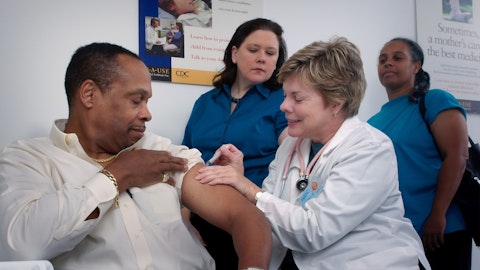Operator: Our next question comes from Eric Joseph of JPMorgan. Your line is open.
Eric Joseph: Thanks. Good morning. In the U.S., looking across the pharmacies that you’ve contracted with to carry the updated vaccine, can you just — like, well, how should we be thinking about their aggregate market share as it relates to seasonal vaccines, perhaps prior COVID seasons, flu seasons? Really getting at the question of how much of a ceiling, Walgreens not being a part of the mix, not being a carrier represents for your product uptake. And I guess should we see perhaps Walgreens revisiting that decision over the further season? Thanks.
John Jacob: All right, Eric. I’ll ask John T to comment. First John maybe on channel share and then the dynamic with Walgreens to…
John Trizzino: Yeah. So I think you’re talking about what is historical channel mix and then what is it looking like so far this year. So I made reference to some of that in the presentation where for flu, what we’re seeing this year is about 65% in retail and 35% in non-retail. That’s approximately accurate for the last five, six plus years or so. And typically, for a seasonal vaccine, for COVID last year, similar statistics and there was about 60%, 70% in retail and a balance in non-retail. We’re just not seeing that at the moment. We’re seeing sub, let’s call it, a few hundred thousand doses in the non-retail channel based upon the IQVIA data that we’re seeing so far. So we expect to see that change a bit in market mix. Consumer behaviors and actions don’t change dramatically in that short period of time, but we’re monitoring that to see if that’s true.
But so far, it’s heavy, heavy retail sector and not yet seeing that shift. What we’re also seeing is a season that’s elongating. Typically for flu, you’d see 50% of the volume before the end of October. Again, we’re not seeing that for COVID and we saw that for COVID last year. So there’s a push for multiple reasons. I think there’s a heavy burden on pharmacy vaccinations that is affecting all that. And so, we’re monitoring it closely, as we said earlier on in the presentation, we’re only three weeks into data that we’re seeing. And so more to come over the next few weeks as we monitor that mix in the market.
James Kelly: And, Eric, I believe the other part of your question was specific to Walgreens for John. And so, we’re in over 14,000 retail outlets in the United States right now with broad distribution and also working with the idea and to make sure if physician network or other channels want the vaccine, it’s readily accessible to them including our participation in the U.S. government bridge program, but John you may want to just put into context the Walgreens piece that Eric’s specific question there I believe.
John Trizzino: Yeah. [Technical Difficulty]
John Jacob: Hello, operator?
Operator: We can hear you.
John Trizzino: Sorry. And it’s important to understand that we’re seeing that through that retail locations for all of the retailers. A great relationship with CVS. I think they’re seeing a lot of vaccines coming through their locations. We’re talking about programs to evolve that communication into the pharmacy to make sure that there’s awareness looking at all any and all other opportunities to create awareness for the consumer as well as awareness for the health care provider and mentioning that earlier that, that awareness and acknowledgement is up over the last couple of months and we expect to see that trend continue.
John Jacob: Eric, I’ll just add. Thank you, John. I’ll just build one point on top of what John so clearly stated there which is that based on CVS alone that roughly 75% of all Americans are within 5 miles of one of their retail outlets. So the vast majority of Americans are very close, if they want our vaccine, they can get our vaccine that was the goal. Would we like to have Walgreens? Absolutely, we continue to work with them. They’re a good partner and will be for the long run, but despite that we’re close to most Americans and if they want our vaccine have access to it that’s the important thing.
Eric Joseph: Okay. Great. Maybe I can ask one follow-up for Jim, just thinking about sort of how the OpEx efficiencies perhaps should be recognized over the course of 2024? And maybe it’s too early for this, but just in thinking about sort of the longer-term outlook, how whether we should anticipate sort of resumption of or build of OpEx in 2025, particularly as you think about obviously self-funding the CIC Phase 3 trial? Thank you.
James Kelly: All right. Excellent. I’m going to begin this with what I’ll call a profile of profitability that we’re driving to. When we think about a long-term sustainable profitable organization, we’re looking to — I would call at least 50% commercial contribution margins. And what I mean by that is, sales minus COGS minus SG&A. All right. And then, of course, you reinvest in R&D under that. In doing so, you really got to get your gross margins and sort of sales minus COGS and that 70% to 80% range. So start with that as, hey, what’s your blueprint to drive this company to be enough fishing and capital or cash producing entity, that’s the vision. And then as we look at the evolution of that through ‘24 and ‘25, while we are describing an urgency to evaluate and act and drive to this cost structure.
We’re not today announcing, for example, a specific restructuring. We’re previewing it for you, but you witnessed us earlier this year act with speed. And so you should expect that we will do so, so that we can recognize as much of those savings as early as possible to fully drive towards that $750 million or less in R&D and SG&A for 2024 while continuing to accelerate the CIC program and driving to a filing in 2025 that in turn could enable a launch as early as 2026. So those are the, I’ll call it the blueprint, the guiding principles for where we’re headed.
Eric Joseph: That’s very helpful. Thanks, Jim. Okay. Thanks for taking the questions, guys.
John Jacob: Thank you, Eric.
Operator: Our next question comes from Brendan Smith from TD Cowan. Your line is open.
Brendan Smith: Hi. Great. Thanks, guys for taking the questions. Just a couple quick ones from us. First, I wanted to clarify something I think I might have heard. For the ex-U.S. approvals, are you still in the process of completing some of these filings, or are they all done and you’re just waiting on actual approval? And can you maybe provide any additional color you have on the potential timing or cadence for the remaining ex-U.S. approvals, kind of just based on your conversations there? It’s kind of really related to Roger’s earlier question, trying to understand just the possibility that any of those might get pushed a little past Q1 just kind of based on the cadence. And then related to that, can you kind of tell us how you’re thinking about that $300 million in Q1?
Have any of the Q4 APAs renegotiated at all or have you actually confirmed delivery in Q1 with some of these territories? Or is this kind of just a best guess based on the current trajectory of how things are going? And then, yeah, and then I have a follow-up. Thanks.
John Jacob: Yeah, John Trizzino, why don’t you take that first question and then we’ll hear the follow-up.
John Trizzino: Yeah. So ex-U.S. approvals, we are still waiting on several — we have U.S. and EMA at this point. We’re waiting on UK, Canada, Australia, New Zealand, Singapore, Taiwan, and also have expectation for WHO regions to be received within the next few weeks. And certainly that will allow us to make those deliveries on many of them before the end of the year and the possibility that some of that timing right roll over into Q1 as we’ve provided some guidance for in that kind of. I’ll leave the explanation of the $300 million in Q1 to Jim.
John Jacob: Yeah. Go ahead, Jim.
James Kelly: Yeah, certainly. As John mentioned, we’ve got secured orders for delivery. If you look at the midpoint of our guidance, you are going to see that we’ve got APAs within that guidance that are approximately $500 million, so-call it sort of 475 to 525 spread of the fourth quarter and the first quarter. And with that said the way things are moving with our supply chain. We’ve got inventory ready to go. It’s really about lining up those deliveries and with some of them like the European deliveries there could be some — it could end up hitting in the fourth quarter in total, but we just don’t want to over promise.



